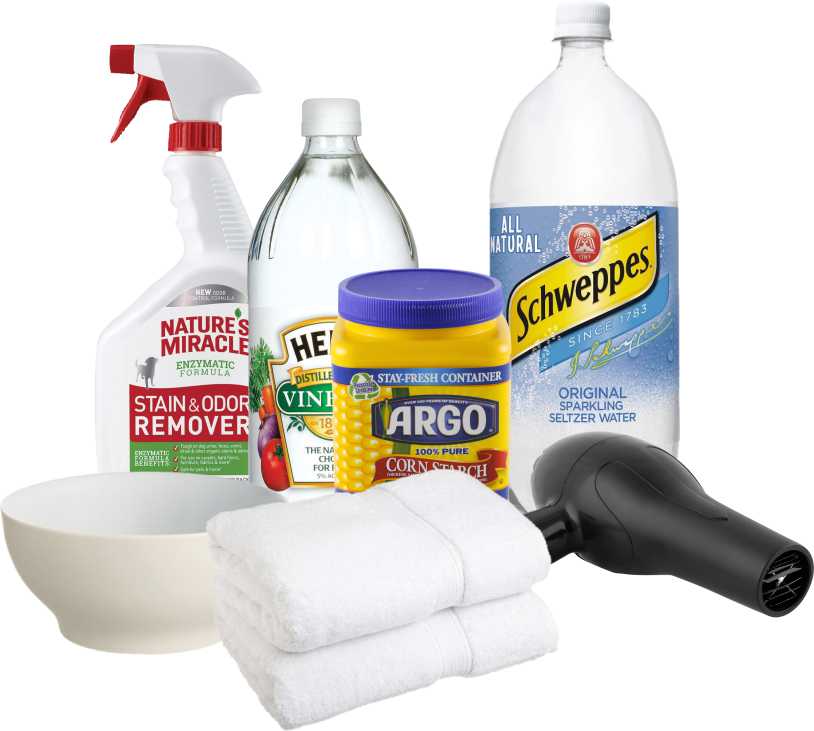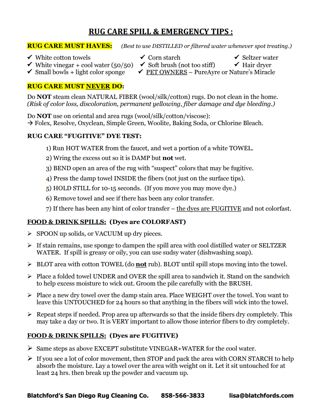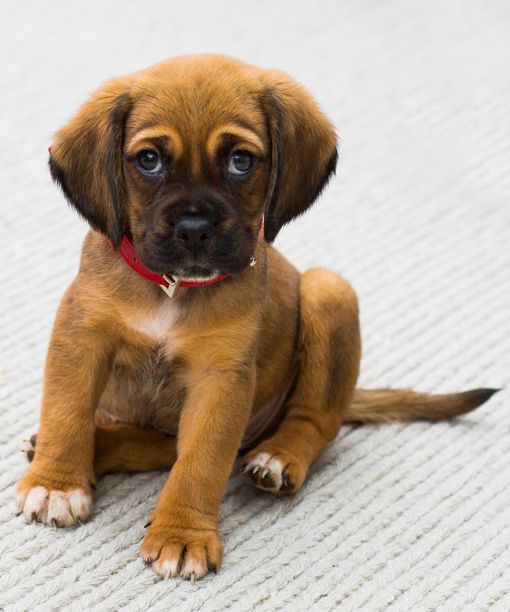Rug Care Spill & Emergency Tips
Read below for our helpful Rug Care Spill & Emergency Tips or use the convenient download button to print and save a copy for quick reference.
Rug Disclaimer: There are many types of rugs, and many types of care issues. These are general recommendations being provided to help in most scenarios involving natural fiber rugs. Please contact us (or your professional rug cleaner in your area if you are not in San Diego) with photos of your rug for specific advice if needed.
IMPORTANT: If your rug is viscose, rayon, bamboo silk, banana silk, Tencel(r), or any other type of artificial silk (regenerated cellulose) – these fibers are wood pulp (paper) and even slight moisture can cause permanent damage. Please contact us, or your trusted rug cleaner, BEFORE any clean up attempts using moisture. (If you are in panic mode, pack the area with corn starch. It will be messy but it will grab the spill faster than these rug fibers in the immediate moment. Many serious spills on these rugs can often ruin these rugs.)

RUG CARE MUST HAVES
(Best to use DISTILLED or filtered water whenever spot treating.)
- White cotton towels
- White vinegar + cool water (50/50)
- Small bowls + light color sponge
- Corn starch
- Soft brush (not too stiff)
- PET OWNERS – PureAyre or Nature’s Miracle
- Seltzer water
- Hair dryer
RUG CARE MUST NEVER DO:
Do NOT steam clean NATURAL FIBER (wool/silk/cotton) rugs. Do not clean in the home.
(Risk of color loss, discoloration, permanent yellowing, fiber damage and dye bleeding.)
Do NOT use on oriental and area rugs (wool/silk/cotton/viscose):
- Folex
- Resolve
- Oxyclean
- Simple Green
- Woolite
- Baking Soda
- Chlorine Bleach.
RUG CARE “FUGITIVE” DYE TEST:
- Run HOT WATER from the faucet, and wet a portion of a white TOWEL.
- Wring the excess out so it is DAMP but not wet.
- BEND open an area of the rug with “suspect” colors that may be fugitive.
- Press the damp towel INSIDE the fibers (not just on the surface tips).
- HOLD STILL for 10-15 seconds. (If you move you may move dye.)
- Remove towel and see if there has been any color transfer.
- If there has been any hint of color transfer – the dyes are FUGITIVE and not colorfast.
FOOD & DRINK SPILLS:
(Dyes are COLORFAST)
- SPOON up solids, or VACUUM up dry pieces.
- If stain remains, use sponge to dampen the spill area with cool distilled water or SELTZER WATER. If spill is greasy or oily, you can use sudsy water (dishwashing soap).
- BLOT area with cotton TOWEL (do not rub). BLOT until spill stops moving into the towel.
- Place a folded towel UNDER and OVER the spill area to sandwich it. Stand on the sandwich to help excess moisture to wick out. Groom the pile carefully with the BRUSH.
- Place a new dry towel over the damp stain area. Place WEIGHT over the towel. You want to leave this UNTOUCHED for 24 hours so that anything in the fibers will wick into the towel.
- Repeat steps if needed. Prop area up afterwards so that the inside fibers dry completely. This may take a day or two. It is VERY important to allow those interior fibers to dry completely.
FOOD & DRINK SPILLS:
(Dyes are FUGITIVE)
- Same steps as above EXCEPT substitute VINEGAR+WATER for the cool water.
- If you see a lot of color movement, then STOP and pack the area with CORN STARCH to help absorb the moisture. Lay a towel over the area with weight on it. Let it sit untouched for at least 24 hrs. then break up the powder and vacuum up.
PET ACCIDENTS:
(Best to use DISTILLED or filtered water whenever spot treating.)
- Pick up solids. If stain remains, or if it is urine, dampen area with VINEGAR+WATER.
- If the urine has gone all the way through the rug to the back, you will have to have the rug professionally washed to try to remove all of the urine from inside the middle of the rug.
- BLOT area with cotton TOWEL (do not rub). BLOT until yellow stops transferring.
- Place a folded towel UNDER and OVER the spill area. Stand on the area to pull out as much moisture as you can from both sides. Place a new dry folded towel on top, place WEIGHT on it (a gallon of water works), and allow the area to sit untouched for at least 24 hrs to allow for any remaining contamination to wick up into the towels. (Don’t peek or absorption will stop.)
- If you are worried about dye bleed in this area, then pack some CORN STARCH in the area on the topside and cover up with the folded towel. Use a spoon to break up the powder to vacuum it up with an upholstery attachment tool. Use a soft brush to brush the powder loose for the vacuum. (Do NOT use baking soda on wool rugs.)
- If odor remains, then MIST top side and back side of area an enzyme spray or deodorizer. Enzymes can damage fibers/dyes so do NOT pour them on any rug, MIST only.
- Prop area up for several days so that the inside fibers dry 100%.
FRESH PET PUDDLES: Pet urine goes on warm and acidic, so it penetrates the fibers completely. Because rug dyes are acid dyes this means urine essentially “re-dyes” the fibers yellow and sets itself. If it is not dealt with immediately, stains can be permanent. You can lessen or remove the odor causing elements with the mentioned steps above.
OLD PET PUDDLE AREAS: Pet stains (7+ days) go from acidic to alkaline in pH, and this damages rug acid dyes resulting in color loss and dye migration in these specific areas. Repeated urine contamination areas foster fungal and bacterial growth. Left alone these areas will dry rot and become holes. Quick clean up is the best rug care tip.
APPLY FIBER PROTECTOR: Applying fiber protector to rugs helps to repel both soil and spills. Today’s formulations do not bulletproof rugs, but they do boost repellency so clean up is much more successful, permanent staining is dramatically lessened, and it helps release soil so that vacuuming is more successful and cleaning times can be extended.
MORE PET TIPS:
- Sprinkle white pepper in areas pets like to mark to help them go someplace else.
- Use kitchen yellow gloves to easily wipe up fur from furniture and rugs. (Sweepa rubber brushes also work great.)
- Use inexpensive synthetic rugs when training pets or during stressful pet times to replace investment rugs or to lay over them to protect from accidents. Dispose when done.
- Use pads to lessen wear on rugs, to prevent sliding, and to protect floor from accidents.
VACUUM weekly: Use upholstery attachment (or canister vacuum) when possible, running the head WITH the grain of the pile (not against it). If using an upright vacuum put the beater bar setting up high to avoid damage and run side to side (so you don’t suck up fringe).
WASH recommendations: Rugs under normal (not heavy) use are to be cleaned every two years. Entry rugs, rugs in rooms with children/pets/allergy sufferers, can be cleaned annually. Rugs vacuumed weekly with moderate foot traffic and no pets can be cleaned every three years.


